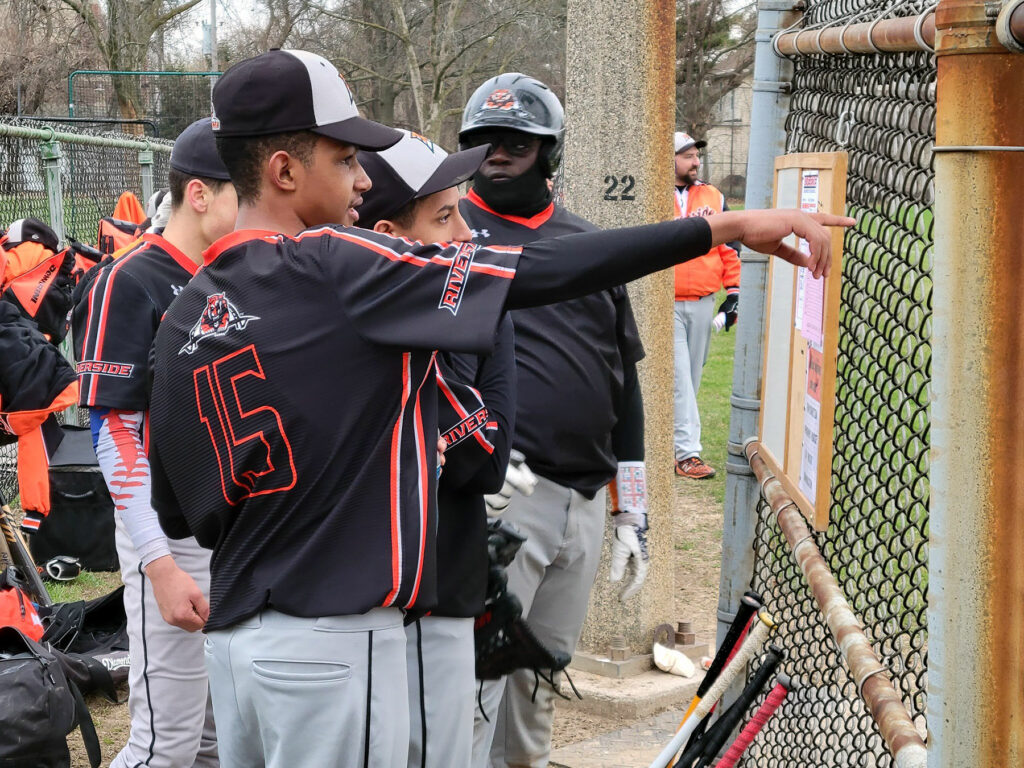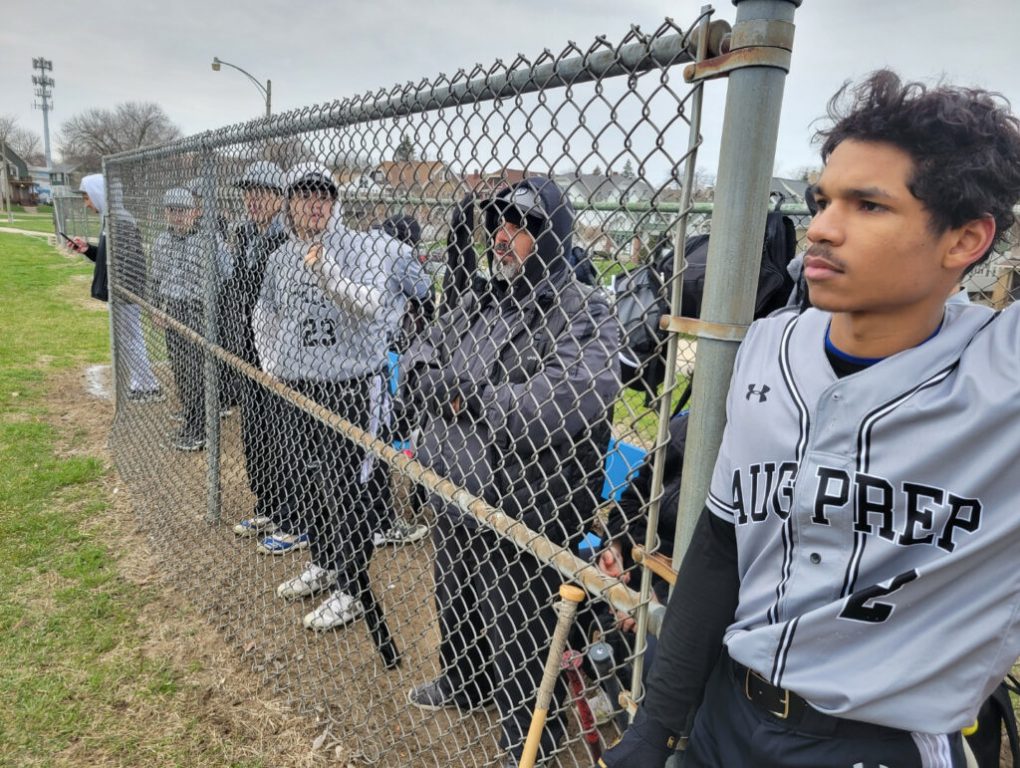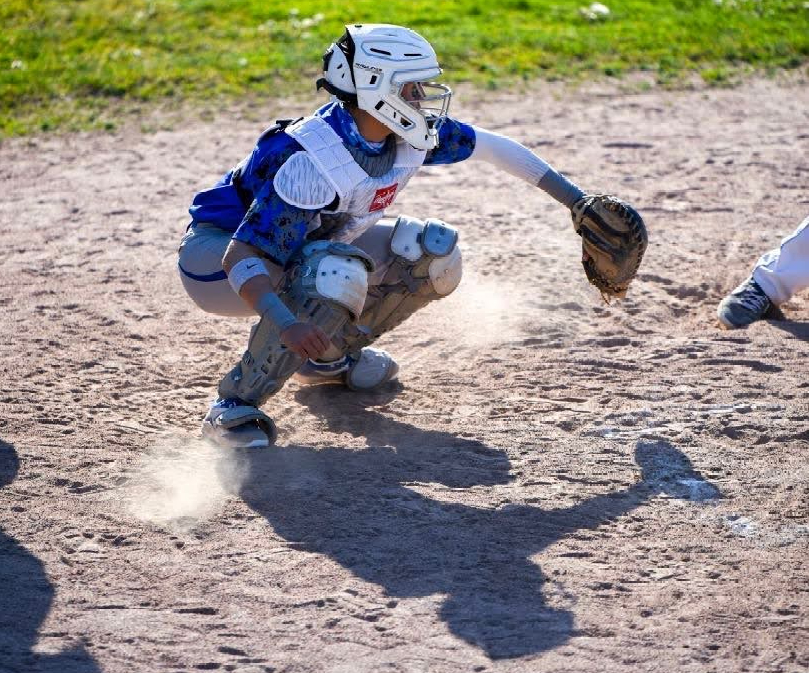The Slow Decline of Milwaukee Youth Sports
First in a two part series.

Riverside High School players (from left) Jalen Flagg (#15), Kevin Pacheco, Jedvier Garcia and Deshaun Owens discuss strategy on the bench during a recent game. Photo by Edgar Mendez/NNS.
As any Brewer fan will tell you, Milwaukee is a baseball town. Yet, many baseball parks across the city sit unkempt and unused, void of the youths that used to fill them in prior decades.
Once firmly atop the perch of recreational youth sports in the area, youth baseball is fading in a major league city with a long history in the sport. Youth baseball leagues have shrunk. The South Side stalwart, Felix Mantilla Little League, now run by Journey House after years at the United Community Center, fielded 22 teams in 2016. It’s down to 12 this season.
The lack of participation has seeped over to impact the sport at the high school level. During a recent game between Riverside High School, a Milwaukee Public School, and St. Augustine Preparatory Academy, a local private school, both teams had just 10 players, only one more than the bare minimum of nine needed to play a game.
‘We just don’t have the money to compete’
The waning numbers are another example of the distressing inequities in opportunities between inner city and suburban youth. Youth sports, advocates say, offer another pathway to higher education and to develop skills, such as discipline and teamwork, that benefit youths as they move into adulthood.
And, if Milwaukee inner city youth are losing interest in baseball, it could be because there is less of an opportunity for them to discover the joys inherent in playing the sport.

St. Augustine Preparatory High School players Robert Buche Gil (#2), Nate Santiago (#23) and Nate Steven Cruz (#7) stand near their coach Julian Haliga. Photo by Edgar Mendez/NNS.
Some of the decline in youth baseball was spurred by COVID, which canceled or delayed local Little League baseball seasons in 2020 and 2021 and deterred some from playing youth sports. But the decline really began years before the pandemic. In fact, the Reviving Baseball in Inner Cities initiative was created in the 1990s by Major League Baseball to stem the decrease in urban participation, especially by Black and brown youths, in the sport and to stave off the type of scenario that is playing out in Milwaukee. The Brewers, asked about its level of support for youth baseball in Milwaukee, did not provide comment for this story.
Those most involved in youth baseball locally say the biggest challenge they face is a resource gap that makes baseball less competitive and appealing for kids in the city to play than it is for those in the suburbs.
Its teams are run by volunteer coaches and the fee for each player to play in the league, the majority of whom are Hispanic or Black, is $1,500, Haliga said. The fee covers league play, six tournaments a year, uniforms and winter instruction.
No player is turned away, Haliga added, but those whose families can’t pay the fees work the concession stands at American Family Field during some Brewer games to raise money, while volunteers and others also help in fundraising.
The money they raise and a $25,000 contribution from the Milwaukee Brewers to the Boys and Girls Clubs of Greater Milwaukee, which administers the RBI program, is not nearly enough to cover the true cost of being competitive in youth baseball, said Haliga, who also coaches baseball at St. Augustine Preparatory Academy on the South Side.
“There are league fees, every team has to have their own equipment like catcher’s gear, bats, game balls, travel and everything else,” said Haliga, who added costs for each team run in the thousands.
Jim Brey has served for the past 20 years as president of the Beckum-Stapleton Little League. He said his league, which charges players $125 to play – a fee that includes uniforms – is also short on supplies.
“Go to the suburbs and each kid has a backpack, two bats, their own gloves and their own helmet, cleats and everything,” said Brey, whose league also fields girls’ softball teams. “That’s not going to happen here, so we deal with donations.”
The impact of a lack of resources is felt far beyond the equipment. Another reason city baseball is struggling, advocates say, is because local leagues can’t afford the type of training players need to cultivate skills they need to compete at higher levels.
“Baseball is a tedious muscle-memory sport that is extremely technical,” Haliga said.
To hone those skills requires instruction from professional coaches, most of whom are experienced ballplayers.
“They teach the kids the nuances of the game, but we can’t afford to hire them so we get volunteers; we get dads,” Haliga said. “I started coaching as a dad 16 years ago.”
Current and former pros do meet on occasion with players at local leagues, including former Milwaukee Brave Felix Mantilla.
Alan Duran, 16, who plays summer ball at Milwaukee RBI and also plays for Ronald Reagan High School at MPS, said even just meeting players who have reached the highest levels of the sport can have an impact.
“It’s cool to meet them and talk a little bit about baseball,” he said. “It’s not enough time to have a long conversation, but you do get to learn about their journey.”
Gap in training facilities
Another challenge that city leagues face is that they can’t afford to train at high-level baseball facilities.
There is one facility on the near South Side, called Heavy Hitters, 415 S. 3rd St. It offers monthly memberships and also personal training. But the majority of such facilities are in the suburbs.
They include the Milwaukee Baseball Academy in Menomonee Falls, Prospect Training Academy in Oak Creek and Hitters Baseball in Caledonia. Hitters is a 44,000 square-foot indoor facility with 16 batting cages, a major league infield, four pitching mounds and a 2,300 square-foot strength training area.
In 2012, when Haliga was coaching the Felix Mantilla Junior All Stars on the South Side, his team received a large discount to train at Hitters. He credited training at the center with helping his team win the first district championship in the Felix Mantilla Baseball League’s history. He said his league can’t afford to train at the center any longer but understands how playing in leagues with access to those types of facilities makes baseball more appealing to young players.

South Sider Alan Duran, 16, has been playing organized baseball since he was 9 years old. Photo provided by Alan Duran/NNS.
“We lose kids to these places because they offer a different level of training and scholarships and exposure,” he said.
Suburban leagues also play on better baseball fields such as the Rock Complex in Franklin, which is part of Milwaukee County Parks system. “The Rock” is a sports and entertainment facility that features fields that meet major league specifications.
Haliga said his teams pay $100 a game to play at more affordable fields at Milwaukee County Parks. He said the fields are often in bad shape, and that they also save some money by scheduling games during the day.
“We play without a scoreboard and without lights,” he said.
“In this city, we played ball,” he said. “All my friends were in Little League, and we played together or against each other, three games a week and two practices.”
As a youngster, Keller played at Beckum-Stapleton and then the North Central Little League, which fields teams from Wauwatosa and the Northwest Side. He went on to earn a scholarship to play baseball at Grambling State University and played ball for UW-Whitewater before joining the travel league circuit as a semi-professional baseball player.
“I’m not going to lie to you; yes, those kids are leaving the city of Milwaukee for better baseball, better coaching and better facilities in the suburbs,” Keller said.
All of these issues combined, advocates say, have now resulted in many local leagues being populated by players who have never played the sport, Brey said.
“Most of those kids that came out last year had never seen a baseball game before,” Brey said. “These kids have drive, but you may have five kids that played before and five kids that have never touched a bat.”
The challenges at the Little League and travel-team level have carried over to affect baseball at Milwaukee Public Schools, said Matt Turner, coach at Riverside High School, 1615 E. Locust St.
Turner has been outspoken about the challenges youth baseball in Milwaukee faces. He said the field his teams play on is unsuited for high level baseball.
“The plate was coming out of the ground, the pitching rubber was about three inches above the ground level, and we have horrible overgrowth,” Turner said.
He also said the players who sign up to play at the high school level are often novices. In the past, players would already have years of experience playing organized baseball under their belts.
“Many kids that we get played baseball in third grade and played one summer and are now trying to get into baseball as a freshman in high school,” he said. “In Milwaukee, we just haven’t done a good job.”
He cites the same challenges as others involved in the sport: a lack of involvement and resources and poor facilities.
“Riverside kids walk half a mile to practice,” he said. “At other places, they are busing to the practice facilities.”
Duran said his team at Reagan has to travel to practice while many of the suburban teams they play against have high-quality fields right in back of their schools.
“It’s a struggle and I guess it holds us back in a sense because when you don’t have places to be in, it makes practice difficult,” said Duran, who’s been playing competitive baseball since he was 9.
A recent report from the Milwaukee Youth Sports Alliance that looked at youth sports highlighted these challenges. The alliance, which includes Bader Philanthropies, the Milwaukee Bucks, America Scores and the Milwaukee Kickers, was created to ensure access to high-quality sports programming in the city as a way to improve mental and physical health.
Barriers to engagement identified in the report included safety and transportation, increased privatization of sports leagues, which reduced access to low-income and low-resource communities, and the COVID-19 pandemic.
The report also offered steps that can be taken to help improve and sustain Little League baseball and other sports opportunities in Milwaukee. Many of those steps include changes in the way leagues are funded, but they also include intangibles such as increasing the number of role models who encourage youths to become involved.
Youth Sports Alliance Executive Director Quentin Prince believes youth sports can be a bigger catalyst for change in Milwaukee and said he hopes the community will rally around historic leagues such as Felix Mantilla and Beckum-Stapleton.
“Back in the day, nine out of 10 kids had connections to Little League baseball,” he said. “We need to bring that engagement and those opportunities back.”
For Turner, it’s about continuing a legacy of competitive baseball at Riverside and about baseball in the city thriving again.
Haliga wants local youths to have access to higher education and scholarships through baseball.
As for Brey, he believes the most important thing is just for kids to have an opportunity to play the game.
“On the North Side here, I think baseball has a special, special place,” he said. “There’s a character development piece of baseball that’s so important for our youth just to make it in today’s society.”
Duran, who said he plays baseball because he loves the sport, offers other suggestions.
“Baseball has its own struggles in terms of popularity with younger people and it starts with the top, the MLB (Major League Baseball),” Duran said. “You look at other leagues and their players are looked at as personalities and celebrities and you can get behind them, but in baseball it’s like you have to be a die-hard fan to be a fan of these players.”
The slow fade of youth sports in Milwaukee was originally published by the Milwaukee Neighborhood News Service.






















As the Brewers suck up millions of taxpayer money — Milwaukee baseball for kids is dying.
There is a lot to unpack in this article. First, there is the question: why is this important? The answer to that is that youth sports are important for kids’ physical, mental, and, if done right, moral, development.
Second, there is the question: is Milwaukee different? Here I believe the answer is “yes” on two levels. The first is the (sad) realization that there was a time when Milwaukee probably stood alone as the national leader in this area. Just two examples: before Little League, Milwaukee had something called Stars of Yesterday (teams were named after former Milwaukee players.) This was a low-cost, urban, working-class version of Little League, played on regular sized diamonds (Merrill, Burnham, Pumping Station), no uniforms, and City Conference baseball players as umpires. There were well over 100 teams in leagues throughout the city.
The thought of a $1,500 fee would have been absurd. The fee for a team to play in the Stars of Yesterday was a firm zero. And, its most striking feature, after a pre-season baseball camp, no adult involvement was permitted. 12-14 year-olds had to organize themselves and get 9 kids to games twice a week. Forfeits were rare.
Next, again in a working-class city, where “summer camp” was someplace the rich kids from suburban schools went, virtually every public-school playground was staffed from 9 a.m. until 8 p.m. with a range of sports and other activities. And, during the school year, while cities like New York were contemplating “after-school programs,” every public school in the city had an after-school “social center,” with sports, cultural arts and other programs every day and evening. These schools were also open for the same programs every Saturday.
Then there were all of the athletic programs run by the Catholic Youth Organization from grade school through the age of 21. Along with the many leagues that were fed by the programs for kids and produced standout athletes and healthy individuals.
The flaw in most of these programs was that they focused exclusively on boys, the revolution in girls an women’s sports still being some years off.
Can any of this be replicated? Who knows? Society has changed. There are different expectations. The city is not the industrial powerhouse that it was. But- a big but – in New York City, on diamonds in places like Central Park that are more poorly maintained than any in Milwaukee, it is rare to find a field without either a baseball or softball game going on. And, the level of play of these youth teams, as well as the adult ones, is extremely high, and, the makeup of these teams and leagues reflects the racial diversity that now defines New York. Answer: it is doable.
Finally, the role of sports in building healthy communities goes well beyond baseball. If anyone wants signs of real hope, look at what Journey House is doing and at the F.E.A.R. (Forget Everything And Run) group. They are the “green shoots” of a brighter future.